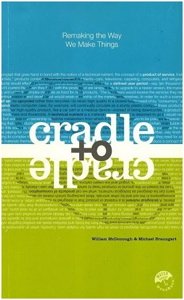|
Cradle-to-Cradle DesignCradle-to-cradle is a term used in life-cycle analysis to describe a material or product that is recycled into a new product at the end of its life, so that ultimately there is no waste. Zero waste. Zero trash. Zero litter. Zero garbage. Nothing to throw away. Can you picture it? (If not, try to find the film
The Next Industrial Revolution
to watch.) I think that children and teens will "get" cradle-to-cradle product design and be able to picture it as soon as they hear about it. It's really just doing things the way Nature always has! Perhaps your students (or children at home) could apply cradle-to-cradle design to their favourite Christmas or other gift. Let's plant this seed while they're still young so that the next generation of product designers does what ought to come naturally — the whole Earth will benefit. Cradle to cradle design refocuses product development from a process aimed at limiting end-of-pipe liabilities to one geared to creating safe, healthful, high-quality products right from the start.

The quotes on the rest of this page are from William McDonough and Michael Braungart, authors of Cradle to Cradle: Remaking the Way We Make Things.
In the biological metabolism, the nutrients
The Practice of C2C Design
Toward a C2C World Natural systems take from the environment but they also give something back. The cherry tree drops its blossoms and leaves while it cycles water and makes oxygen; the ant community redistributes nutrients through the soil. We can follow their cue to create a more inspiring engagement — a partnership — with nature. We can create fabrics that feed the soil, giving us pleasure as garments and as sources of nourishment for our gardens. We can build factories that inspire their inhabitants with sunlit spaces, fresh air, views of the outdoors, and cultural delights; factories which also create habitat and produce goods and services that re-circulate technical materials instead of dumping, burning, or burying them. We can tap into natural flows of energy and nutrients, designing astonishingly productive systems that create oxygen, accrue energy, filter water, and provide healthy habitats for people and other living things. As we have seen, designs such as these are generators of economic value too. When the cradle-to-cradle principles that guide them are widely applied, at every level of industry, productivity and profits will no longer be at odds with the concerns of the commons. We will be celebrating the fecundity of the earth, instead of perpetuating a way of thinking and making that eliminates it. We will be creating a world of abundance, equity and health and well on our way to an era of sustaining prosperity. — William McDonough and Michael Braungart
William McDonough's TED Talk: Cradle to Cradle Design |

